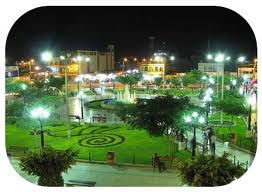The City Ica
The city of Ica is the capital of the Ica Region in southern Peru. While the area was long inhabited by varying cultures of indigenous peoples, the Spanish conquistador Geronimo Luis de Cabrera claimed it’s founding in 1563. As of 2005, it had an estimated population of over 219,856. The city suffered extensive damage and loss of life during the 2007 Peru earthquake
Location
The city is located on the Ica River about 300 km to the south of Lima, along the desert coast of southern Peru. Further south along the Pan-American Highway lies the city of Nazca.
History
In 2007, researchers found the fossil remains of a prehistoric penguin, Icadyptes salasi, which inhabited the Atacama Desert about 30 million years ago. Scientists estimate it was about 4.5 or five feet tall, with a foot-long beak.
Evidence of prehistoric indigenous civilizations has been found in the nearby deserts, such as that of Paracas. These included the xx, Paracas, and Inca, the last of who were a people who encountered the Spanish. Numerous pre-Columbian archeological artifacts are displayed in the Museum Regional de Ica.
The Spanish colonial city was founded in June 17, 1563 by Geronimo Luis de Cabrera as Villa de Valverde. It was ruled by Spain under colonial rulers until Peru achieved independence.
On 15 August 2007, a magnitude 8.0 earthquakes occurred off the coast of Peru, severely damaging buildings, houses and infrastructure in Ica. Initially 17 people died and 70 were killed when a church collapsed. Pisco was even more severely damaged than Ica, with many people buried under buildings which had fallen; 80% of the city's buildings were destroyed.
Transportation
Ica can be reached from Lima by the Pan-American Highway. The distance is almost exactly 200 miles or 300 km. The trip takes about 4.5 hours by bus and 4 hours on motorcycle.
Tourism
Ica and surrounding areas are the traditional source of Pisco brandy. Ica is the site of the Museum Regional de Ica, a regional museum with exhibits ranging from prehistoric artifacts to the Spanish colonial era. On display are pre-Columbian funerary bundles and mummies, whose elongated skulls from the Paracas and pre-Inca cultures suggest ritual deformation, perhaps a mark of the elite. Some skulls also bear evidence of trepanning; a kind of early brain surgery to relieve internal pressure or remove damaged skull matter suffered in battle. There are also furniture, paintings and artifacts from the Spanish colonial era.
Ica's location in the desert provides unique opportunities for tourism, such as the nearby Huacachina oasis, located in the midst of sand dunes. It attracts international travelers, as well as resort seekers from Peru. Some young visitors try sand boarding; others travel the dunes in sand buggies.
Agriculture
The many days of sunshine have made Ica the center of an important agricultural region. Commodity crops are cotton, grapes, asparagus, olives and other produce. It is known by Peruvians as the "Land of the Sun". Although there are the four seasons, the warm dry climate makes it feels like summer year-round. The climate of the city can help in easing asthma, which is aggravated by damp and humid climates and their associated allergens.
But given the desert climate, agriculture has been relying on an aquifer fed by glacial melt water, and is currently exceeding the inflow of water into the aquifer. The aquifer is quickly drying up, leading to calls for more efficient irrigation, or adding dams and water diversions.
City of Ica
Capital of the Ica Department. One of the most popular places to visit in Ica is La Huacachina. The famous desert oasis is located 5 km from Ica. It is a small lake with medicinal water, lying in the middle of a spectacular sand desert.Pisco
Pisco the most important port in Ica and a littoral province. The most important attractions within this province are likely Paracas, Paracas Bay and the Paracas National Reserve. Pisco was home of an ancient pre-Hispanic culture, Paracas, who are known for their exquisite textiles.Paracas
Paracas (a municipality within the Paracas District) is a small town catering to tourism. It serves as the jumping point for tours to Islas Ballestas and to Paracas National Reservation. The beautiful Paracas Bay protected by Paracas Peninsula gives these shallow, warmer waters break from ocean waves permitting life to flourish, particularly near its south western edge encompassed within Paracas National Reserve. The Paracas Museum, also found just near the south western edge of Paracas Bay, provides excellent information about Paracas culture and the many unique species, in particular, the birds of Paracas.Nazca
The Ica-Nazca culture flourished along the southern coast of Peru from around 200 BC to 600 AD. This area is extremely dry. The Nazca developed extensive irrigation systems, including underground canals that allowed them to farm the land. The Nazca are known for their beautiful textiles and pottery which feature images of animals and mythological beings.They are even more famous, however, for an extraordinary but puzzling set of creations known as the Nazca Lines, which are geoglyphs and geometric line clearings in the Atacama desert, in the district of Nazca. On a large, rock-strewn plain, the Nazca made huge drawings by scraping away stones to reveal the lighter soil underneath. The drawings depict various plants and animals, including humans, a monkey, birds, and other creatures, as well as lines and geometric shapes. These drawings are so huge, however, that they can be seen only from the sky. Scientists believe that the Nazca made these drawings for their gods. The area of the Nazca lines is called the Pampa Colorada (red plain).













